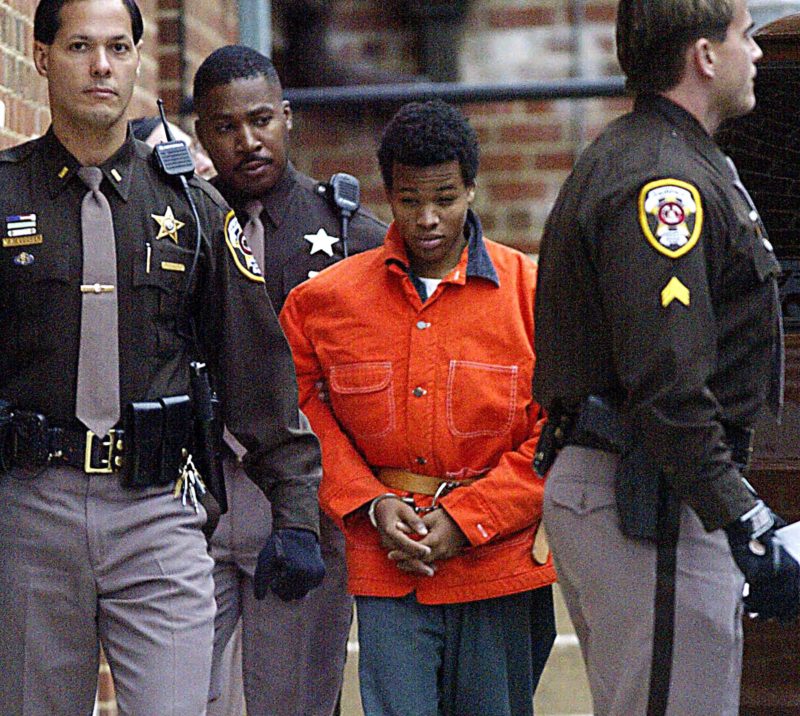Supreme Court to hear sentencing case for ‘Washington sniper’
The Supreme Court is to hear arguments in the case of ‘Washington sniper’ Lee Boyd Malvo, seen here in a 2002 file photo (LUKE FRAZZA)
Washington (AFP) – He has described himself as a “monster” and confessed to his crimes. Lee Boyd Malvo was 17 years old when he and an accomplice carried out a deadly three-week shooting spree that terrorized the Washington area in 2002.
Malvo was sentenced to life in prison without parole and the Supreme Court is to hear arguments on Wednesday on whether such a sentence can be meted out to a juvenile.
The nation’s top court is hearing the case after a court in Virginia ruled that Malvo deserved another sentencing hearing because his age at the time was not taken into account.
Virginia’s attorney general appealed the ruling and the Supreme Court will be deciding whether its 2012 and 2016 rulings that mandatory life sentences for minors are unconstitutional applies retroactively to Malvo’s case.
The series of sniper shootings paralyzed the Washington area. Ten people were killed and three wounded in Virginia, Maryland and the US capital.
Malvo, who was 17 when he was arrested, was given a total of 10 sentences of life in prison without parole in Maryland and Virginia.
Malvo’s partner in the shooting spree, John Allen Muhammad, was executed in 2009.
During the October 2-22, 2002 shooting spree, Muhammad, a 41-year-old US Army veteran and skilled marksman, and Malvo picked off random victims with a high-powered sniper rifle.
The killings terrified an area still living in dread of the September 11, 2001 terror attacks and deadly anthrax mailings a year earlier.
People would squat down by their cars as they pumped gas, run from their vehicles into work, or just stay home.
Malvo and Muhammad, who was a father-like figure to the teenager, were apprehended after an exhaustive manhunt by federal and local police.
Muhammad’s motive was unclear, although one of his ex-wives alleged he intended to shoot her and reclaim custody of their three children.
Malvo, in a 2012 interview with The Washington Post, said “I was a monster.”
“If you look up the definition, that’s what a monster is,” he said. “I was a ghoul. I was a thief. I stole people’s lives. I did someone else’s bidding just because they said so.”
– ‘Prison with no hope’-
Malvo’s lawyers acknowledge that whatever the nine-member Supreme Court rules, he is unlikely to be freed anytime soon.
Nevertheless, the court hearing has resurfaced strong emotions surrounding the case.
The Trump administration has argued that the court should not provide an “escape hatch” that would allow Malvo to avoid stiff punishment for his “heinous crimes.”
In a brief, the Maryland Crime Victims’ Resource Center said “liberty and justice for all does not allow the consideration of only the interests of criminal defendants.
“They demand that victims’ interests be fully considered.”
At least one of Malvo’s victims, Paul LaRuffa, who was shot five times, supports revisiting his sentencing.
“After my experience, I was of the opinion that the life without parole sentence for Malvo was absolutely justified using the argument that, at 17 years old, he knew the difference between right and wrong,” LaRuffa told AFP.
“Since that time, I have learned more about juvenile brain development, psychological development, as well as many successful juvenile rehabilitation stories.
“It was easy for me, after my experience, to have the, ‘Put him in jail and throw away the key,’ opinion, but my view has changed, not necessarily concerning Malvo in particular, but the many other youthful offenders convicted and sentenced to life without parole.
“I feel that there is a better answer in our justice system than dooming juveniles to a life of 40, 50 or 60 plus years in prison with no hope.”
Disclaimer: Validity of the above story is for 7 Days from original date of publishing. Source: AFP.


